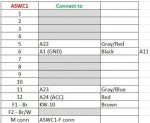I gave up on the (in)capabilities of the Honda head unit and decided to replace it for my 2017 RTL. One of my main goals was to have no splices to RL wiring so I could put back the stock equipment if needed. I outline the main points of my experience for those who would like to try this.
First, here are some threads that helped me.
Very detailed head unit replacement thread:
http://www.ridgelineownersclub.com/forums/161-2g-audio-bluetooth-electronics-navigation/140489-base-radio-swap-info.html
2016 Pilot info on connectors and removal/disassembly (applies to 2017 RL):
2016 Honda Pilot Service Info - Honda Pilot - Honda Pilot Forums
I went with a Kenwood receiver. Boot up time, quick availability of rear view camera image were the key factors in the selection. I guess you can’t go wrong with any head unit compared to the stock Honda ships with. I also installed a small Kenwood amp for the subwoofer. Existing wiring were used for speakers, steering wheel control, rear view camera, FM antenna, USB, and Bluetooth microphone. I was not able to use the Honda BT microphone – it is powered with DSP that optimizes reception for different use cases. Although I applied power and used attenuators on the output, the sound had noise and clipping. At the end, I replaced the Honda microphone with the Kenwood one, using RL wiring. I had to do one single splice on the reverse wire since that was not available in any connector that I could find.
Challenging parts were populating the Metra harness with additional connector pins (RL used more pins than the Metra connector offered), wiring the amp power lines from the battery, and getting the mike to work. Android auto is very finicky with respect to USB wiring – I had to select good quality cables to get consistent results.
It took me a couple of weekends to get this done with all the trial and error testing and quite of bit of online research. Overall functionality is much better than what I had. And I had fun.
First, here are some threads that helped me.
Very detailed head unit replacement thread:
http://www.ridgelineownersclub.com/forums/161-2g-audio-bluetooth-electronics-navigation/140489-base-radio-swap-info.html
2016 Pilot info on connectors and removal/disassembly (applies to 2017 RL):
2016 Honda Pilot Service Info - Honda Pilot - Honda Pilot Forums
I went with a Kenwood receiver. Boot up time, quick availability of rear view camera image were the key factors in the selection. I guess you can’t go wrong with any head unit compared to the stock Honda ships with. I also installed a small Kenwood amp for the subwoofer. Existing wiring were used for speakers, steering wheel control, rear view camera, FM antenna, USB, and Bluetooth microphone. I was not able to use the Honda BT microphone – it is powered with DSP that optimizes reception for different use cases. Although I applied power and used attenuators on the output, the sound had noise and clipping. At the end, I replaced the Honda microphone with the Kenwood one, using RL wiring. I had to do one single splice on the reverse wire since that was not available in any connector that I could find.
Challenging parts were populating the Metra harness with additional connector pins (RL used more pins than the Metra connector offered), wiring the amp power lines from the battery, and getting the mike to work. Android auto is very finicky with respect to USB wiring – I had to select good quality cables to get consistent results.
It took me a couple of weekends to get this done with all the trial and error testing and quite of bit of online research. Overall functionality is much better than what I had. And I had fun.






